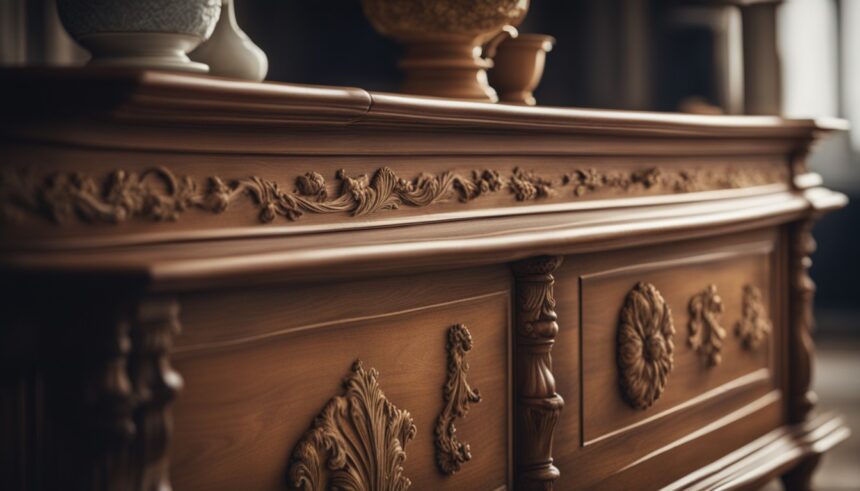Antique furniture exudes charm, character, and history that modern pieces often lack. Owning antique furniture can be a source of pride, but it also comes with the responsibility of proper care and maintenance. One common dilemma antique enthusiasts face is how to clean their cherished pieces without resorting to stripping, which can potentially damage the furniture’s original finish and value. In this comprehensive guide, we will explore the best practices for cleaning antique furniture without stripping it. Whether you’re a seasoned collector or just starting to appreciate the beauty of antiques, this article is a valuable resource for preserving the integrity and beauty of your cherished pieces.
Why Avoid Stripping Antique Furniture?
Before delving into the techniques for cleaning antique furniture without stripping, it’s essential to understand why stripping is often discouraged. Stripping refers to the process of removing the existing finish and surface layers from a piece of furniture. While it may seem like a quick fix to rejuvenate the piece, it can have detrimental effects on its value and aesthetic appeal. Here are a few reasons why stripping should be avoided:
1. Loss of Originality
Stripping antique furniture removes the original finish and patina that have developed over time. The patina is a thin layer that forms on the surface of wood due to age and use, giving the piece a unique character and color. Once the patina is gone, it’s nearly impossible to replicate, and the piece loses its historical authenticity.
2. Decreased Value
Antique furniture derives much of its value from its age, historical significance, and original finish. Stripping can significantly reduce the value of a piece, as collectors and enthusiasts often prefer furniture in its original state.
3. Potential Damage
Stripping can be a harsh process that risks damaging the wood, especially if not done correctly. Chemical strippers can penetrate the wood and weaken its structure, potentially causing cracks and warping.
Now that you understand the importance of preserving the original finish on antique furniture, let’s explore effective methods for cleaning and maintaining these treasured pieces.
Gathering Your Supplies
Before you begin cleaning your antique furniture, gather the necessary supplies. Here’s a list of items you’ll need:
1. Soft Cloths
Choose soft, lint-free cloths that won’t scratch or damage the wood’s surface. Microfiber cloths work exceptionally well.
2. Mild Cleaning Solutions
Use a mild, non-abrasive cleaning solution. Crafting your personalized solution is as easy as blending a small amount of dish soap with warm water.. Alternatively, you can purchase a commercial wood cleaner designed for antique furniture.
3. Soft Bristle Brushes
Soft-bristle brushes, like paintbrushes or toothbrushes, are excellent for cleaning intricate details and crevices without causing any harm.
4. Vacuum Cleaner with Brush Attachment
A vacuum cleaner with a brush attachment is helpful for removing dust and debris from hard-to-reach areas and crevices.
5. Beeswax Polish or Paste Wax
To protect and enhance the wood’s natural beauty after cleaning, you’ll need a high-quality beeswax polish or paste wax.
Here is How to Clean Antique Furniture Without Stripping: The Step-by-Step Cleaning Process
Now that you have your supplies ready, let’s walk through the step-by-step process of cleaning antique furniture without stripping:

Step 1: Dusting
Begin by dusting the entire surface of the furniture with a soft cloth or a vacuum cleaner with a brush attachment. Pay close attention to crevices, carved details, and any nooks and crannies where dust tends to accumulate.
Step 2: Test a Small Area
Before applying any cleaning solution, it’s essential to test a small, inconspicuous area of the furniture to ensure that the wood and finish won’t be negatively affected. Apply a small amount of your chosen cleaning solution to a hidden spot and wait a few minutes to see if any adverse reactions occur.
Step 3: Cleaning
Once you’ve determined that the cleaning solution is safe to use, dampen a soft cloth with the solution and gently wipe down the surface of the furniture. Work in small sections, using a light touch to avoid excess moisture. For intricate details and tight spaces, use a soft-bristle brush to clean.
Step 4: Rinse and Dry
After cleaning, rinse the cloth in clean water and wring it out thoroughly. Wipe down the furniture again with a damp cloth to remove any residue from the cleaning solution. Finally, dry the furniture with a separate dry cloth to prevent water spots.
Step 5: Apply Beeswax Polish or Paste Wax
To protect the wood and restore its luster, apply a thin layer of beeswax polish or paste wax. Follow the manufacturer’s instructions for application. Allow the wax to dry, and then buff the surface with a clean, soft cloth to achieve a beautiful, glossy finish.
Frequently Asked Questions
Q1: How often should I clean my antique furniture?
A1: The frequency of cleaning depends on factors like the environment and usage. In general, a thorough cleaning once or twice a year is sufficient. However, routine dusting and occasional touch-ups with beeswax polish can help maintain the furniture’s appearance.
Q2: What should I do if my antique furniture has stains or watermarks?
A2: For stains or watermarks, it’s best to consult a professional antique restorer. Trying to handle the situation on your own could potentially exacerbate the existing damage. In the meantime, avoid placing hot or wet items directly on the furniture to prevent further staining.
Q3: Can I use furniture polish sprays on antique furniture?
A3: It’s best to avoid modern furniture polish sprays on antique furniture, as they may contain harsh chemicals that can harm the wood and finish. Stick to beeswax polish or paste wax specifically designed for antique care.
Q4: How can I prevent further damage to my antique furniture?
A4: To prevent damage, avoid exposing your antique furniture to direct sunlight, extreme temperatures, and high humidity. Use coasters, placemats, and tablecloths to protect the surfaces from spills and heat.
Conclusion
Cleaning antique furniture without stripping is a delicate process that requires care, patience, and the right tools. By following the steps outlined in this guide, you can preserve the originality and beauty of your cherished pieces for generations to come. Remember that antique furniture is not only a testament to the craftsmanship of a bygone era but also a link to history, and proper care ensures its longevity and continued enjoyment. So, embrace the joy of owning antique furniture and embark on a journey of preservation and appreciation. Your efforts will be rewarded with furniture that tells a story and adds warmth and character to your home.







